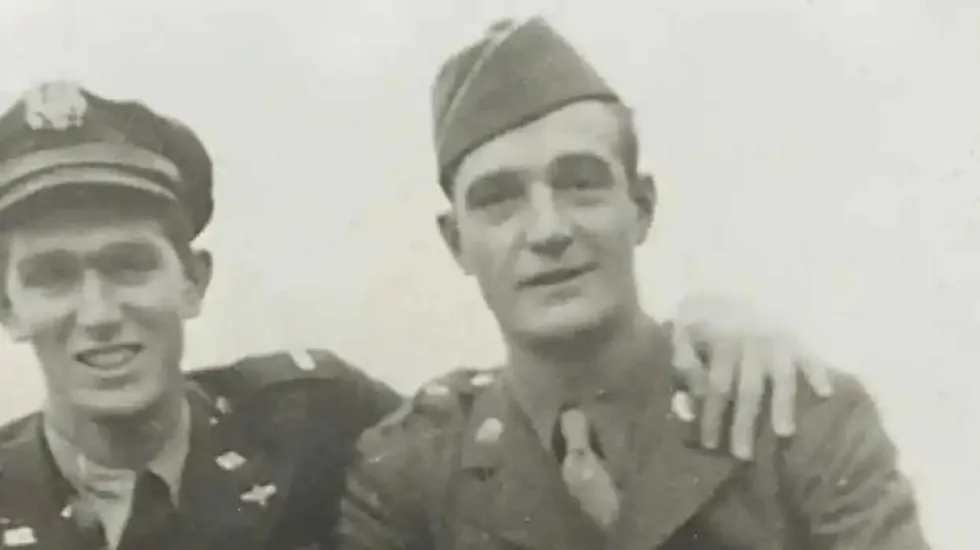September 2, 1945. The mighty battleship USS Missouri and an armada of hundreds of ships waited patiently for the end of the biggest, most destructive conflict the world had ever seen.
The American forces had been anchored in Tokyo Bay for a few days. They were surrounded by naval mines, having been carefully escorted into the port of the enemy they’d devastated with two nuclear bombs just weeks before. Many suspected it was a trap.
‘This is a permanent memorial so that anybody walking up to that grave site can read their story for decades to come on their phones.’
But just after 9 a.m. local time, Japanese and American delegations met on the ship’s deck to sign documents formalizing the unconditional surrender of the Empire of the Sun. The war was over.
As part of the surrender ceremony, 1,500 Allied aircraft flew in formation over Tokyo Bay as a massive show of force mere minutes after the signing. The weight of the moment was obvious to everybody involved, so much so that many Americans went out of their way to see it firsthand.
One last mission
Meanwhile, the business of war continued. The 16th Bombardment Group in Guam was scheduled to participate in the flyover, but American prisoners of war were still in need of supplies. Lt. George R. Hutchison’s B-29B bomber had been grounded due to mechanical issues, and so he volunteered for a mercy mission aboard another bomber to drop goods on Osaka.
Hutchison would not live to celebrate with his fellow soldiers. Two hours into the mission, a low-speed runway crash shredded and burnt the plane, taking his life and the lives of eight others. Only three men survived.
Lt. Hutchison was one of 30 servicemen to give their lives on the day World War II ended. He would be buried in Honolulu, Hawaii, and leave behind a widow, Eleanor.
Honoring the fallen
The tragic fate of Lt. Hutchison is one of nearly 78,000 stories that have been carefully preserved by Stories Behind the Stars, a volunteer group that has spent nearly a decade researching and cataloging the life stories of the hundreds of thousands of Americans who died in World War II.
Since 2016, hundreds of volunteers from across the United States and several international volunteers have collaborated to document stories like this to honor the fallen.
Drawing upon military records from Ancestry.com, headstone applications, census records, and newspaper archives, project volunteers have contributed obituary-length short essays on thousands of profiles in a publicly available database. These trained volunteers are usually able to pull together a profile in two or three hours, and many contribute hundreds per year.
Among the project’s greatest feats has been a complete catalogue of all WWII veterans at Arlington National Cemetery and Pearl Harbor’s USS Arizona Memorial, two of America’s largest memorial sites. Users can find the history of every serviceman listed at both memorials.
“When you look at flowers on a grave, they disappear after a week,” Stories Behind the Stars founder Don Milne tells Align. “This is a permanent memorial so that anybody walking up to that grave site can read their story for decades to come on their phones.”
RELATED: John J. Pinder Jr.: Baseball hero who chose greater sacrifice

Lunchtime hobby
Milne, a Kentucky-based bank examiner and member of the Church of Latter-day Saints, never expected the project to gain as much traction as it did; it began in 2016 as something to do on his lunch break, he tells Align.
The father of six and grandfather of 15 launched Stories Behind the Stars on the 75th anniversary of Pearl Harbor and planned to end the project with the 75th anniversary of VJ Day in 2020.
But as Milne continued at a consistent pace, writing one story per day, what began as a humble, personal blog was soon attracting millions of views. Dozens of volunteers contacted Milne, wanting to help. It quickly grew into a much larger project, one that Milne ultimately handed off to other leaders. (He remains a part-time contributor.)
“It really took off during COVID, when a lot of people were stuck in their houses,” he says. “They heard about this project and thought it was something to do while stuck in their home. And year after year, we’ve done more and more projects. We’re not professionals. We’re not getting paid to do this.”
New recruits
Milne and the other volunteers soon realized they needed more help to do the project justice:
We did the math and said if we did one story per day, it would take us 1,000 years to write this many stories, but said, why one per day? Why not get more volunteers? We brainstormed and thought that if we put everything into this blogspot, nobody would know it’s there, so we need to save it in a database. We reached out to Ancestry.com, which has billions of records and military records, and asked them if they would host this database for us. They agreed and put it outside their firewall, so nobody has to pay to look at these records.
Volunteers wanted
The need to gather and document firsthand accounts of World War II grows more urgent with each passing day. Of the 16 million Americans who served in the global conflict, fewer than 50,000 are still alive. Most of them are in their late 90s or 100s, and it is expected that they will all be gone by 2035.
The need to memorialize those who never grew old is no less urgent — and no less daunting. Stories Behind the Stars intends to record all of the nearly half a million service members who died between 1941 and 1946 — a massive undertaking that could take decades. At its current pace, the organization anticipates having 25% of the project complete by the end of 2026.
Grassroots efforts such as Stories Behind the Stars are doubly important considering the gaps in government recordkeeping, says Milne:
There isn’t an official tally of how many people died in World War II. Our organization is probably going to find it eventually when we add up all the names by the time we’re done. But even the organization that runs the national WWII memorial in DC doesn’t know what the total is. They didn’t have computers in 1946 when they put the records together. They did their best with index cards, but they didn’t get everyone.
The project’s stable of regular volunteers includes a group of devoted veterans, retirees, and researchers, and they are always looking for more help! Even if it’s just a single article, they appreciate the contributions of people who step up to tell their family’s stories as much as devotees who make a hobby out of regularly assisting.
“Visit our website, and we’ll send you information on how to volunteer!” says Milne. “We provide free training and free access to tools. There’s never any financial obligation to participate. We’re lean and mean! We just need bodies to sit at a computer.”
Stories Behind the Stars can be reached through its website and Facebook page. Check out its YouTube and completed projects pages to learn more.















